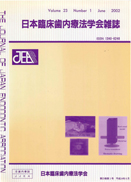Volume 17, Issue 2
Displaying 1-13 of 13 articles from this issue
- |<
- <
- 1
- >
- >|
Review Article
-
1996Volume 17Issue 2 Pages 133-139
Published: 1996
Released on J-STAGE: June 30, 2019
Download PDF (1368K) -
1996Volume 17Issue 2 Pages 140-150
Published: 1996
Released on J-STAGE: June 30, 2019
Download PDF (4781K) -
1996Volume 17Issue 2 Pages 151-161
Published: 1996
Released on J-STAGE: June 30, 2019
Download PDF (7851K)
Original Article
-
1996Volume 17Issue 2 Pages 162-166
Published: 1996
Released on J-STAGE: June 30, 2019
Download PDF (4373K) -
1996Volume 17Issue 2 Pages 167-174
Published: 1996
Released on J-STAGE: June 30, 2019
Download PDF (6927K) -
1996Volume 17Issue 2 Pages 175-178
Published: 1996
Released on J-STAGE: June 30, 2019
Download PDF (2610K) -
Effects of argon laser irradiation with 38% Ag(NH3)2 F on the permeability of root canal wall dentin1996Volume 17Issue 2 Pages 179-184
Published: 1996
Released on J-STAGE: June 30, 2019
Download PDF (5090K) -
1996Volume 17Issue 2 Pages 185-189
Published: 1996
Released on J-STAGE: June 30, 2019
Download PDF (2764K) -
1996Volume 17Issue 2 Pages 190-196
Published: 1996
Released on J-STAGE: June 30, 2019
Download PDF (5601K) -
1996Volume 17Issue 2 Pages 197-203
Published: 1996
Released on J-STAGE: June 30, 2019
Download PDF (3914K) -
1996Volume 17Issue 2 Pages 204-211
Published: 1996
Released on J-STAGE: June 30, 2019
Download PDF (4853K) -
1996Volume 17Issue 2 Pages 212-216
Published: 1996
Released on J-STAGE: June 30, 2019
Download PDF (3364K)
Medical Essay
-
1996Volume 17Issue 2 Pages 260-264
Published: 1996
Released on J-STAGE: June 30, 2019
Download PDF (2628K)
- |<
- <
- 1
- >
- >|
